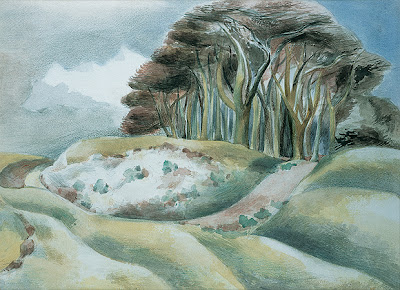 |
| Paul Nash, Wittenham (1935) |
Modernity has not been particularly kind to Nash's special Places. The magical Iver Heath, where he painted gardens and elm trees, is now a short, fast jaunt from the M25 or the M4, and the ancient landscape surrounding Wittenham is dominated today by the power station at Didcot.
Rather than despair at this evidence of Progress, the website's authors suggest that the surrealist in Nash would have enjoyed the juxtaposition of ancient hillforts and modern chimneys. I'm not sure that I agree. He did after all dedicate his 'Shell Guide to Dorset' to 'All those courageous enemies of development to whom we owe what is left of England', and he was not at all happy when Avebury was spruced up for the tourist industry in the late 1930s.
He would have loathed power stations and motorways and those giant warehouses that nowadays spring up almost overnight close to strategic junctions. Although it isn't manmade structures that now block his long-range view of the Clumps from Boars Hill, but fully-grown trees.

2 comments:
I am a poet living in the Cotswolds and as a boy of nine years old living in Didcot, I used to get up early during the long, school summer holidays, pack myself some sandwiches and a flask of tea then bike out to the Clumps. I would push my bike up to the top of Castle hill - this would have been c.1951/2 as I was born the year that Nash first became aware of Wittenham Clumps - and sit gazing out over the Vale. It was my private place and filled me with an almost holy rapture mixed with a primal fear. I would never look behind me at the copse at my back which seemed to have an animal presence,watching me..............I have written a poem based on these memories called "Green Man Rising" in which I, as an adult, try to recapture the feelings of that young boy.
Thanks Anonymous - who are you? Can I read your poem? I know that feeling of rapture and fear... My email is on the Illustrated Talks page if you'd like to tell me more
Post a Comment